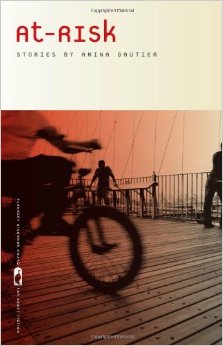Portraits of Struggle: A Review of Amina Gautier’s At-Risk
As a middle-class, white female from a rural area in Western New York, reading has always been a way for me to learn about other people and their lives. Amina Gautier’s At-Risk, an engaging collection of short stories about the lives of young African Americans, introduced me to characters unlike any I have met before—in life or in literature.
At-Risk was published in 2011 by the University of Georgia Press and is the winner of the 2011 Flannery O’Connor Award for Short Fiction. In At-Risk, Gautier explores narratives that are often ignored and characters who are dismissed by society. The collection includes ten short stories, beginning with “The Ease of Living,” the story of a boy from Brooklyn named Jason. He is sent by his mother to live with his elderly grandfather in the South after his two friends are killed during a gunfight on the streets. Jason resents his exile, but his grandfather’s home provides him an unlikely sanctuary in which to cope with the deaths of his friends and consider what that means for him.
This short story is immediately followed by “Afternoon Tea,” which is narrated in first-person by Dorothy, a first-generation American and daughter of a formerly wealthy Jamaican woman. Dorothy goes to a Saturday program hosted by members of a professional women’s sorority, but she is acutely aware that these women are trying to divorce her and the other girls from their mothers and their upbringing. This reality is exquisitely exposed in the line, “The Zeta Alpha Deltas had not been subtle in the least way about their desire to wean us from the women they didn’t want us to become.” Though their identities and backgrounds are different, Dorothy and Jason are both examples of the desire to be loyal to one’s environment despite the harm that environment can bring. The choice to open the collection with these two stories as reveals the many potential risks and obstacles in place for these young people.
While the characters in Gautier’s collection might be linked by the term “at-risk,” the reader comes to understand the inaccuracy of such a term. The main characters are of different ages, from elementary school age to adolescence. All of them are acutely aware of the pressures of a world that expects them to fail. This is highlighted in the story “Pan is Dead,” in which a gifted boy, Peter, is faced with the return of his father, who has a history of drug abuse and is a portrait of what Peter could become if he doesn’t use his intelligence to escape. The story is narrated by Peter’s younger sister, and she draws attention to the conflict of race and success with the lines, “‘Boy, you can’t be president.’ This much I knew. Everyone knew that the president was always white and never from Brooklyn.” This is especially interesting commentary from a collection published after the inauguration of President Barack Obama, but it reminds the reader that the image of a black man in the highest office in the nation had previously been unimaginable to young black people.
One of the collection’s most striking features is the envelope technique it employs to complete the book. The closing piece of the collection, “Yearn,” returns to characters from the first story, “The Ease of Living.” The story is not about Jason, however. It is the story of his friend Stephen, one of the two who was shot and killed. This image of a boy before his tragic and untimely death is a heartrending reminder that the term “at-risk youth” is applied to real people in our world. Though Dorothy, Peter, and Jason are all fictional characters, there are young people just like them with real desires and passions which often end up stymied by situations out of their control and choices that they never planned to make.
Gautier’s work is poignant, compassionate, and breathtaking in its humanity. The characters scream and whisper and declare, delivering their stories in a way that resonates in one’s bones. I won’t soon forget the characters I’ve met here: whether feisty or bewildered, determined or forsaken, they have much to say about the perils of adolescence, especially as it intersects with poverty and racism.
